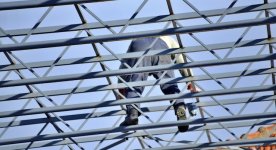Structural steel is revolutionizing the construction industry, becoming a preferred choice for residential, commercial, and industrial projects. With its unmatched strength, design flexibility, and cost-efficiency, steel framing is making traditional materials seem outdated. But why exactly is this material gaining so much attention, and how can it benefit your next building project?
In this article, we’ll explore the key advantages of structural steel, touch on how it influences construction costs, and highlight why it's the smart choice for future-ready buildings. Whether you're a contractor, builder, or property owner, understanding these benefits can guide smarter investment decisions.
Key Benefits:
Example: A commercial warehouse built using structural steel can be completed in a fraction of the time compared to traditional methods. This efficiency enables businesses to become operational sooner.
Applications Include:
Plus, structural steel is often made from recycled content and is itself fully recyclable at the end of its life cycle. That contributes to a lower carbon footprint for any construction project.
For an in-depth breakdown of current cost considerations, check out this detailed guide on metal building prices.
Additionally, steel structures are less susceptible to mold, pests, and rot—common issues that compromise structural integrity over time.
Choosing steel is not just about today's needs—it’s about building for tomorrow. With its long-lasting value and environmental benefits, it’s no surprise that more professionals are turning to steel as the backbone of their projects.
In this article, we’ll explore the key advantages of structural steel, touch on how it influences construction costs, and highlight why it's the smart choice for future-ready buildings. Whether you're a contractor, builder, or property owner, understanding these benefits can guide smarter investment decisions.
What Is Structural Steel and Why Is It Popular?
Structural steel is a category of steel used specifically for making construction materials in various shapes. Unlike traditional wood or concrete, steel offers superior tensile strength and resistance to external elements, making it ideal for long-lasting, durable structures.Key Benefits:
- Durability: Structural steel can withstand natural disasters like earthquakes, storms, and high winds better than many traditional materials.
- Precision: It’s fabricated off-site with exact specifications, leading to fewer on-site errors and faster assembly.
- Recyclability: It’s 100% recyclable, making it an environmentally responsible choice.
Faster Construction Time and Lower Labor Costs
One of the most significant advantages of structural steel is the speed of construction. Pre-fabricated steel components can be manufactured and delivered to the site, significantly reducing build times. A faster build means lower labor costs, minimal disruptions, and quicker return on investment.Example: A commercial warehouse built using structural steel can be completed in a fraction of the time compared to traditional methods. This efficiency enables businesses to become operational sooner.
Versatility in Design and Functionality
Structural steel allows for more open spaces and creative design elements that are not always possible with wood or concrete. Architects and engineers appreciate the freedom it offers to innovate without compromising safety or functionality.Applications Include:
- High-rise buildings
- Industrial warehouses
- Modern residential homes
- Bridges and public infrastructure
Energy Efficiency and Sustainability
Steel-framed buildings are easier to insulate, which helps in reducing heating and cooling costs. Additionally, steel structures can be fitted with energy-efficient windows, solar panels, and modern HVAC systems more seamlessly than other materials.Plus, structural steel is often made from recycled content and is itself fully recyclable at the end of its life cycle. That contributes to a lower carbon footprint for any construction project.
Comparing Costs: Initial Investment vs. Long-Term Value
While some might assume steel is expensive, it often proves more economical over time. Lower maintenance, quicker construction, and durability make it a smart investment. When comparing costs, it’s important to consider not just the upfront price but the lifecycle value of the building.For an in-depth breakdown of current cost considerations, check out this detailed guide on metal building prices.
Enhanced Safety and Fire Resistance
Safety is a top concern in any construction project. Steel offers a higher degree of fire resistance compared to wood, which can significantly slow the spread of flames. This property is particularly valuable in commercial and industrial buildings, where fire risk is a constant consideration.Additionally, steel structures are less susceptible to mold, pests, and rot—common issues that compromise structural integrity over time.
Minimal Maintenance and Long-Term Performance
Once installed, structural steel requires minimal upkeep. Unlike wood, it doesn’t warp, crack, or shrink. Unlike concrete, it doesn’t degrade due to moisture or chemicals. A simple periodic inspection and occasional repainting can keep a steel structure in excellent condition for decades.Conclusion: The Smart Future of Building
Structural steel has clearly positioned itself as a frontrunner in the construction world. Its blend of strength, efficiency, and sustainability offers a superior alternative to conventional materials. Whether it’s reducing costs, speeding up timelines, or enabling innovative design, structural steel checks every box for modern builders and investors.Choosing steel is not just about today's needs—it’s about building for tomorrow. With its long-lasting value and environmental benefits, it’s no surprise that more professionals are turning to steel as the backbone of their projects.

